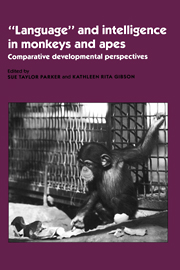Book contents
- Frontmatter
- Contents
- List of contributors
- Foreword
- Preface
- Acknowledgments
- Part I Theoretical frameworks for comparative developmental studies
- Part II Comparative developmental perspectives on cebus intelligence
- Part III Questions regarding imitation, “language,” and cultural transmission in apes and monkeys
- Part IV Developmental perspectives on social intelligence and communication in great apes
- Part V Development of numerical and classificatory abilities in chimpanzees and other vertebrates
- Part VI Comparative developmental perspectives on ape “language”
- Index
Foreword
Published online by Cambridge University Press: 11 May 2010
- Frontmatter
- Contents
- List of contributors
- Foreword
- Preface
- Acknowledgments
- Part I Theoretical frameworks for comparative developmental studies
- Part II Comparative developmental perspectives on cebus intelligence
- Part III Questions regarding imitation, “language,” and cultural transmission in apes and monkeys
- Part IV Developmental perspectives on social intelligence and communication in great apes
- Part V Development of numerical and classificatory abilities in chimpanzees and other vertebrates
- Part VI Comparative developmental perspectives on ape “language”
- Index
Summary
We live in an era of new disciplines. They emerge for different reasons, often because explosions of knowledge in several related areas permit, indeed demand, reorganization and new syntheses. Such has been the case with cognitive science, ecology, and, in the present instance, “comparative developmental evolutionary psychology,” hereinafter CDEP.
But one asks, almost immediately, Didn't Darwin and others do it in the last century? Aren't The Descent of Man and The Expression of Emotions in Man and Animals prime examples of CDEP? Yes and no. Until one reads this volume, one might advance a tentative yes. But the work reported here shows how far short of the mark the Darwin cohort fell. They simply did not have the densely packed, detailed information necessary to describe the behavior of “closely related species in the same genus” (S. T. Parker's watchword). One obvious consequence of this paucity of knowledge was Darwin's careful refusal to publish a concrete taxonomy of the primates. A branching tree diagram is the only illustration in On the Origin of Species, but it is highly abstract, and Darwin used it only to make very general points about the process of evolution. Versions of the tree diagram appear throughout Darwin's notes, beginning in 1837, and one might have expected that by 1871, when he published Descent, he would have hazarded a concrete taxonomy.
Information
- Type
- Chapter
- Information
- 'Language' and Intelligence in Monkeys and ApesComparative Developmental Perspectives, pp. xi - xiiiPublisher: Cambridge University PressPrint publication year: 1990
